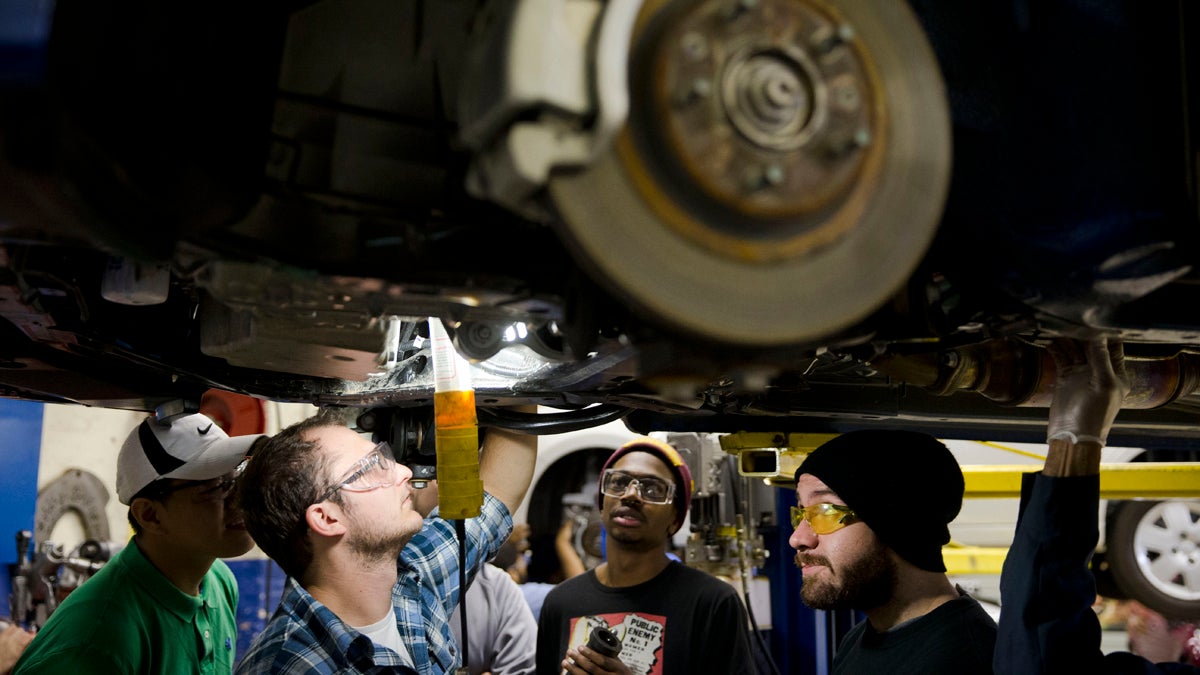Even with funds flowing, community colleges are reeling from budget impasse

Automotive service technology students work on a car at the Community College of Philadelphia, in Philadelphia, Pa. (AP File Photo/Matt Rourke)
Loan payments and credit downgrades mean that the state’s community colleges won’t recover right away.
Some of the upsides of a community college — lower tuition, shorter programs, local funding contributions — have quickly become challenges during the budget impasse. Pennsylvania’s 14 community colleges have been hurt by the six month delay, and may continue to feel the pinch even though state funds have been released.
Jim Hrabosky has been the vice president for administration and finance at Butler County Community College (BCCC) for 10 years now. He says this has been the most stressful year on the job.
“I’m not used to checking our bank account daily,” said Hrabosky. “But everyday, I was checking that number and watching it get lower and lower.”
Community colleges are funded by student tuition, state funds and a local partner — in this case, Butler County.
The school was able to make it through most of the fall semester without the expected $8 million in state funding. But then, thanks to the budget delay, Butler County pushed its quarterly payment to the school from December to January. Tuition money wouldn’t arrive until the new semester started in January, as well.
The school didn’t have the funds to make it through the end of 2015.
“We essentially needed 30 days of cash to get through the month of December,” said Hrabosky.
Loans and fees
BCCC borrowed against $2 million of a $3 million line of credit. With a partial budget passed in Harrisburg, the school is expecting to receive half of their annual allocation next week. They’ll use most of that to pay back the loan. Between interest and origination fees, the school spent about $9,000 on the loan — money they don’t expect to get back from the state.
Community College of Allegheny County (CCAC) took out $8.1 million in loans. If they pay it back by Jan. 22, fees and interest will total $31,000, the equivalent of one year’s tuition for 10 students, according to the Pittsburgh Post-Gazette.
Bucks County Community College acquired a line of credit, but the state funding was released before it had to take the loan.
“They were prepared for that contingency,” said Marta Kaufmann, spokeswoman for the college. “And for the near future, the school is going to be keeping that line of credit open.”
Credit downgrade
The money is flowing again to the colleges, and soon the loans will be paid off. But the saga isn’t quite over.
In October, financial firm Moody’s Investors Service downgraded the credit rating of three community colleges in the state. Another four had their outlooks revised to negative, though their credit ratings remain the same.
A lower credit rating makes future borrowing more expensive, adding higher interest rates to loans for construction or maintenance.
Both CCAC and the Community College of Philadelphia (CCP) were downgraded from A1 to A2. In a press release about CCP, Moody’s wrote, “the downgrade…reflects the college’s narrowing liquidity resulting from the ongoing commonwealth budget impasse and increasing limitations on expense flexibility.”
BCCC was downgraded from A1 to A3. The school has failed to hit enrollment targets for the past two years and was already working with slimmer margins, according to Hrabosky.
“We’ve had two years of operating deficits, which contributed to one slot downgrade. But the second downgrade was because of the state,” said Hrabosky. “I’m calling it a shared responsibility.”
Historically, community colleges in Pennsylvania were funded equally by the state, the local sponsor and tuition. Over the years, budget cuts have eroded those first two sources. Tuition now makes up a much larger percentage of the operating costs — 50 to 70 percent in most cases.
Governor Tom Wolf’s original budget proposal included an increase in funding for community colleges. Now, after six months of waiting, the schools will have to take what they can get, and hope that next year will run more smoothly.
WHYY is your source for fact-based, in-depth journalism and information. As a nonprofit organization, we rely on financial support from readers like you. Please give today.


